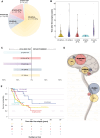Distinct relapse pattern across molecular ependymoma types
- PMID: 39171767
- PMCID: PMC11726240
- DOI: 10.1093/neuonc/noae166
Distinct relapse pattern across molecular ependymoma types
Abstract
Background: Ependymoma (EPN) is not a uniform disease but represents different disease types with biological and clinical heterogeneity. However, the pattern of when and where different types of EPN relapse is not yet comprehensively described.
Methods: We assembled 269 relapsed intracranial EPN from pediatric (n = 233) and adult (n = 36) patients from European and Northern American cohorts and correlated DNA methylation patterns and copy-number alterations with clinical information.
Results: The cohort comprised the following molecular EPN types: PF-EPN-A (n = 177), ST-EPN-ZFTA (n = 45), PF-EPN-B (n = 31), PF-EPN-SE (n = 12), and ST-EPN-YAP (n = 4). First relapses of PF-EPN-B (PF: posterior-fossa) and PF-EPN-SE (SE: subependymoma) occurred later than of PF-EPN-A, ST-EPN-YAP (ST: supratentorial), or ST-EPN-ZFTA (median time to relapse: 4.3 and 6.0 years vs. 1.9/1.0/2.4 years; P < .01). Metastatic or combined recurrences in PF-EPN-B and -A more often involved the spinal cord than in ST-EPN-ZFTA (72.7% and 40.0 vs. 12.5%; P < .01). No distant relapses were observed in ST-EPN-YAP (n = 4) or PF-EPN-SE (n = 12). Post-relapse survival (PRS) was poor for PF-EPN-A and ST-EPN-ZFTA (5-year PRS: 44.5% ± 4.4%/47.8% ± 9.1%), whereas PF-EPN-B and PF-EPN-SE displayed a 5-year PRS of 89.5% ± 7.1%/90.0% ± 9.5% (P = .03). However, 10-year PRS for PF-EPN-B dropped to 45.8% ± 17.3%. Neither between the radiation field and relapse pattern nor between the radiation field and spinal involvement at relapse an impact was identified. Notably, all patients with relapsed ST-EPN-YAP did not receive upfront radiotherapy but were successfully salvaged using irradiation at relapse.
Conclusions: Relapse patterns of specific EPN types are different. Future clinical trials, treatment adaptions, duration of surveillance, and diagnostics should be planned to incorporate entity-specific relapse information.
Keywords: ependymoma; metastatic; recurrence; relapse.
© The Author(s) 2024. Published by Oxford University Press on behalf of the Society for Neuro-Oncology. All rights reserved. For commercial re-use, please contact reprints@oup.com for reprints and translation rights for reprints. All other permissions can be obtained through our RightsLink service via the Permissions link on the article page on our site—for further information please contact journals.permissions@oup.com.
Conflict of interest statement
The authors declare no competing interests.
Figures


References
-
- McGuire CS, Sainani KL, Fisher PG.. Incidence patterns for ependymoma: A surveillance, epidemiology, and end results study. J Neurosurg. 2009;110(4):725–729. - PubMed
-
- Classification of Tumours Editorial Board, WHO Classification of Tumours: Central Nervous System Tumours, 5th edn. Vol 62021.
MeSH terms
Substances
Grants and funding
LinkOut - more resources
Full Text Sources
Medical

